World War Two was a total war, and the Allies had to mobilize their whole economies to produce the weapons and supplies needed to fight it. That restricted what was left for the civilian population, and rationing was introduced to make sure everyone got a fair share of scarce resources.
In the US, rationing was fairly mild; gasoline was rationed, and so were some “luxuries” like coffee and sugar, but most foods were still easily available.
However, in Britain, it was very different. Because the UK imports a lot of its food, and this was a lot more difficult when German submarines were sinking every ship they could, food was in short supply – and rationing was very strict.
For most of the war, a British adult was rationed to one egg a week. They could buy 8oz of bacon or ham, and around 20oz of other meat. Moreover, dairy products were severely restricted, with the weekly ration adding up to 2oz of cheese and 2oz of butter. Half a pound of sugar a week, 4oz of margarine, 4oz of lard… it isn’t much.
Related: How To Stockpile Lard, The Calorie Rich Survival Food Of The Great Depression
Luckily potatoes, vegetables and bread weren’t rationed, so people could bulk out their diet with those, but a plate of boiled potatoes and cabbage isn’t exactly the most exciting meal. To keep morale up through six long years of war, people had to get creative with their rations.
So, here are some of the recipes they came up with:
Lord Woolton Pie
Named after Lord Woolton, the wartime Minister of Food, this filling pie was created by the head chef at London’s Savoy Hotel in 1941. Its main ingredients are potatoes and other root vegetables – whatever was available.
Ingredients:
- 1 1/2 pound potatoes
- one lb. swede
- one lb. carrots
- 1 pound cauliflower, parsnips or rutabaga
- 4 spring onions
- 1 tablespoon oatmeal
- 1 vegetable bouillon cube
- Water
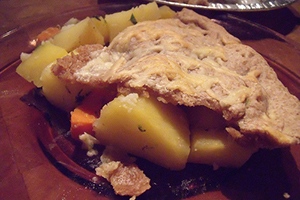 Dice a pound of the potatoes and the swede, carrots and other vegetables. Chop the spring onions finely. Put it all in a pan with the oatmeal and crumbled bouillon cube, add just enough water to cover the vegetables, bring to the boil then simmer on a low heat for ten minutes, stirring occasionally.
Dice a pound of the potatoes and the swede, carrots and other vegetables. Chop the spring onions finely. Put it all in a pan with the oatmeal and crumbled bouillon cube, add just enough water to cover the vegetables, bring to the boil then simmer on a low heat for ten minutes, stirring occasionally.
When the vegetable mixture is cooked, drain it (save the liquid) then allow to cool. Simmer the cooking liquid to reduce and thicken it. Peel, cook and mash the remaining potatoes; add some butter or lard if you have it.
When the diced vegetables have cooled put them in a greased pie dish and pour some of the thickened cooking liquid over the top to act as a sauce.
Sprinkle with chopped parsley (fresh or dried) if you have it. Spread the mashed potato over the top and bake in a moderate oven until the crust is browned.
Patriotic Pudding
Carrots had been a favorite vegetable in Britain since Roman times, but under rationing people found many new uses for them. Carrot cake became popular in the UK during WWII, and people adapted the same principle to replace traditional fruit puddings.
Related: 5 Survival Foods Made By Soldiers During WW2 On The Normandy Front
“Patriotic Pudding” was a steamed pudding with a vegetable touch.
Ingredients:
- ¼ cup flour
- ¼ cup grated raw potato or fine oatmeal
- 1 tablespoon margarine or butter
- 1 finely grated carrot
- ½ tablespoon jelly or molasses
- ½ teaspoon baking soda
- Pinch of salt
- 2 teaspoons grated citrus rind (optional)
- Milk (if available) and water to mix
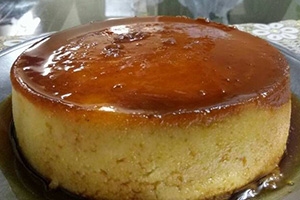
Rub the fat into the flour to make a crumbly mixture. Add the potato or oatmeal, baking soda and salt, and the citrus rind if you’re using it. Mix well.
Add the jelly and carrot, and four tablespoons of heated milk or water. After that, mix until smooth, put it in a well-greased bowl, cover with foil and steam for an hour.
Moreover, serve with custard if you have it, or a spoonful of jelly or maple syrup.
Wartime Potato Soup
You’re probably already getting the idea that potatoes were a big part of the rationing-era diet. Yes they were, and people were always looking for new ways to make them more interesting.
For instance, one option was this popular soup, which makes a great winter appetizer – or even a meal on its own.
Related: How to Make Portable Soup
Ingredients:
- 2 large potatoes
- 1 large onion
- 4 medium leeks
- 3 sticks celery
- one quart vegetable broth
- a tablespoon of oil
- 1 tbsp. chopped parsley (fresh or dried)
- 1 tbsp. fresh thyme leaves (optional)
 Chop the leeks, celery and onion. Dice the potatoes. Heat the oil in a saucepan and fry the vegetables over a low heat for five minutes.
Chop the leeks, celery and onion. Dice the potatoes. Heat the oil in a saucepan and fry the vegetables over a low heat for five minutes.
Secondly, add the potatoes and thyme (if you have it), and fry for another five minutes. Stir in the broth and bring to a low simmer.
Thirdly, cover and cook for around 30 minutes until the vegetables are soft. Blend until smooth, or puree by forcing it through a sieve with a wooden spoon. Add more hot broth if it’s too thick. Spoon into bowls, garnish with the chopped parsley and serve.
Cheese and Lentil Spread
The cheese ration was far from generous, and people tried everything they could to make it stretch further.
A popular recipe, first used in WWI and then brought back during WWII, used unrationed lentils, bread and onions to bulk up the cheese ration and make a tasty sandwich spread.
Related: 30 Long Lasting Recipes Grandma Made During WWII
Ingredients:
- 2 ounces cheese
- 2 ounces red lentils
- 1 ounce breadcrumbs
- 1 ounce onions
- ½ ounce lard or butter
- Chopped parsley
- Salt and pepper
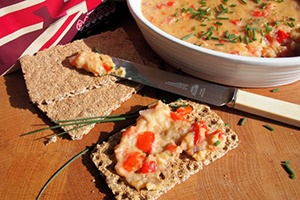
Firstly, grate the cheese and set aside in a bowl. Peel and finely chop the onion, wash the lentils and cook them with the onion in a little water, stirring occasionally.
When the lentils have nearly finished cooking add the mixture to the grated cheese, stir in the breadcrumbs and lard or butter, season well with salt, pepper and chopped parsley and mix it all together thoroughly.
Use as a sandwich filling or on toast.
Carrot Curry
Indian food has been popular in Britain for a long time, but with meat strictly rationed during the war it was hard to create favorite recipes.
Ingenious cooks soon realized they could use unrationed carrots as a substitute, though. This is a simple, filling and nutritious recipe that still manages to be tasty.
Ingredients:
- 1 pound carrots
- 1-ounce margarine or lard
- a large onion
- 2 teaspoons curry powder
- I tablespoon flour
- ½ pint broth
- 1 teaspoon sugar
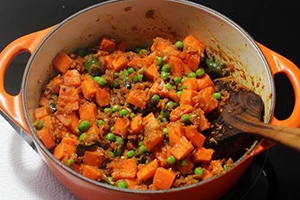
Chop the carrots and boil or steam them. While they’re cooking (don’t overdo them) melt the fat in a saucepan, chop the onion and fry until soft. Then, add the curry powder and flour and fry for another couple of minutes, stirring often. Stir in the broth and bring to the boil, then season well with salt and pepper.
Also, add the sugar and a teaspoon of vegetable extract if you have it. Simmer the sauce gently for about 20 minutes, then add the carrots and cook for another ten minutes. Serve with rice; for the authentic 1940s British curry taste, sprinkle some raisins and grated dried coconut on top.
Related: How to Dry Can Beans and Rice for 20+ Years Shelf Life
Wartime Meat Gravy
What do you do when you love meat but can’t get enough of it? One option is to make a big batch of rich meat gravy and use it to add the right taste to vegetable-based dishes like Lord Woolton Pie.
A week’s meat ration, bought as ground beef, will make enough of this beefy sauce to flavour your carrots and potatoes all week.
Ingredients:
- 8 ounces ground beef
- 8 ounces over-ripe tomatoes (if you have them)
- a large onion
- 1 beef bouillon cube
- Salt and pepper
- Dried thyme if available
- Water
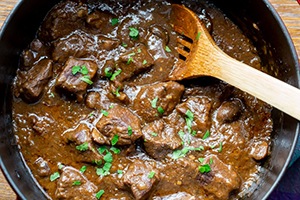 Firstly, brown the ground beef in a saucepan with the finely chopped onion. Add a pint of water and the bouillon cube, and stir as you bring it to a simmer.
Firstly, brown the ground beef in a saucepan with the finely chopped onion. Add a pint of water and the bouillon cube, and stir as you bring it to a simmer.
Then, season well with salt, pepper and thyme if you have it. Chop the tomatoes up small and add them to the gravy.
Simmer on a low heat for at least 20 minutes; thicken with cornstarch if needed. To serve, spoon some over potatoes (boiled or mashed) or Woolton Pie.
In conclusion, this is just a sample of wartime rationing recipes. There were many more – as many as there were ingenious cooks who wanted to eat well even with a restricted diet.
Here are some more examples:
-
- Vegetable turnovers: these vegetable-stuffed pastry crusts are big and filling. They’re also portable, making them an idea option for a wartime packed lunch.
-
- How do you make cake frosting when sugar is strictly rationed? You make it from mashed potato, of course!
- Dried fruit was still available during the war, but it could be in short supply. One way to make it go further was by baking a date and carrot tart.
- Carrots and potatoes for dinner again? Liven up the meal you’ve had every day since 1939 by turning it into a tasty French-style vegetable ragout.
- Make your tiny ration go further by enjoying a big plate of cheap and unrationed cauliflower, livened up with small amounts of bacon and cheese.
- Spam spam spam spam wonderful spam! But your ration points only let you buy a couple of cans a month. Enjoy Spam-loaded potato hash to make it go further.
Try some of these wartime recipes, and let us know what you think in the comments – and feel free to share any of your own!
You may also like:
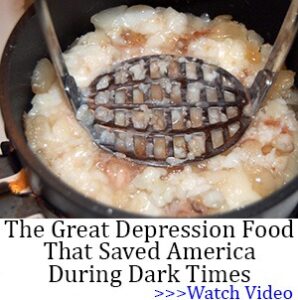 The Best Long-Lasting Protein Sources for a Crisis
The Best Long-Lasting Protein Sources for a Crisis
This Hidden Survival Garden Will Keep You Well Fed When SHTF (Video)
Prepping for People with Hearing, Sight, and Speech Disabilities

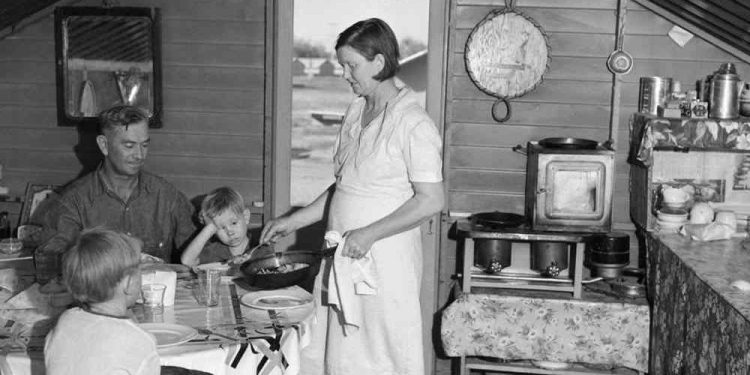




















Great article.
I LOOOOOOOVE HOOVER STEW
If you want a real view of rationing in the UK, check out a BBC series on You Tube called “Wartime Farm”. It’s lengthy (8 one hour episodes), but very enlightening. This American had no idea the totalitarian lengths the British government went in their control of the rural and city people. Well worth a watch.
Yes excellent information in the Wartime Farm series. The archaeologists in the series also appeared in “Tales from the Green Valley” about life in mediaeval times. I particularly liked the episode where Ruth mixed up some dough then took it in the bowl into the field to catch spores and wild yeasts so that the bread would rise!
Ron,
Thanks for the recommendation for wartime farms. Started watching last night. Very good!!
Thanks again,
Peace,
MadFab
I watch it repeatedly. A superbly educational series.
Having been born in 1941, I lived through this rationing time in America. Fortunately, I don’t remember much about it. But Momma always reminded us of the necessity of NOT WASTING ANYTHING!
I was born in 1935, so I do remember most of it. We ate a lot of rabbit, chicken, squirrel, and woodchuck. Today I can do without chicken and squirrel. We had a large garden and chickens so we were better off than a lot of people.
I do not understand all of the “thumbs down” in this thread.
Perhaps they have never been hungry.
I grew up eating squirrel, dove and deer, as well as what we grew in the garden.
My mom’s family farmed. She didn’t recall any “hardships” during depression times or WWII, when we talked about it. But her parents were from a rather rustic part of southern Europe, they were used to it, knew how to deal with it; that was just how they lived before they emigrated. Their practices — canning, drying, keeping a good pantry — that would get them through winter until the next growing season, came with them, and stayed with them, and was passed onto us grandkids. Proud of my heritage and grateful what I learned from my parents and grandparents.
jomama — That’s exactly it. They’ve never been truly hungry.
In case one wonders what swede is, my dictionary says that it is a British term for rutabagas. Learn something every day if you are not careful.
Thanks – I like Rutabagas but had no idea that a “swede” was such. I was envisioning myself “DISECTING” A HANDSOME, 6′ 2″ hunk!!!
Olivia: That was not the swede I had in mind.
Princess Madeleine is my idea of ‘Swede.’
LCC
You saved me from looking it up.
I wonder how our current crop of Americans would take to food rationing? An interesting supposition for sure I believe.
With so many picky eaters and so many with food allergies, it could be very problematic. Of course, not being a guy who really eats oatmeal, if truly hungry I would attack it with gusto. We always have it on hand as the wife is a huge fan of it!!
Consco: Yes, I think most would be amazed at what suddenly becomes very appetizing after three days of slightly muddy looking water. Oatmeal is a great survival food. It’s light weight. It is nutritious. You can cook it overnight in a thermos by just adding boiling water and letting it sit overnight. And you would be pleasantly surprised how absolutely tasty it would be after the aforementioned three days even without half&half, walnuts and raisins in it.
I would sadly say, most Americans would rather come over to your house and brake in and take anything or everything you have rather than do the unthinkable and cut back and live by someones RULES!
count on them being a bitchy lot
Read the book 1 Second After, most would die within a year.
I’m quite confident that a whole lot of us spoiled Americans will feel as though we are being punished if we had to ration and eat some of these things. I certainly hope things don’t get that bad, but it could be a valuable lesson to all of us. We should be thankful everyday for our abundant blessings and stop being so wasteful.
After permitting over 60million abortions… most likely it this would be among many chastisements that we must necessarily humbly accept.
Fergus is just a tad off in the variety of items rationed. This is from the U.S. History website I cited earlier:
“Rationing regulated the amount of commodities that consumers could obtain. Sugar rationing took effect in May 1943 with the distribution of “Sugar Buying Cards.” Registration usually took place in local schools. Each family was asked to send only one member for registration and be prepared to describe all other family members. Coupons were distributed based on family size, and the coupon book allowed the holder to buy a specified amount. Possession of a coupon book did not guarantee that sugar would be available. Americans learned to utilize what they had during rationing time.
“While some food items were scarce, others did not require rationing, and Americans adjusted accordingly. “Red Stamp” rationing covered all meats, butter, fat, and oils, and with some exceptions, cheese. Each person was allowed a certain amount of points weekly with expiration dates to consider. “Blue Stamp” rationing covered canned, bottled, frozen fruits and vegetables, plus juices and dry beans, and such processed foods as soups, baby food and ketchup. Ration stamps became a kind of currency with each family being issued a “War Ration Book.” Each stamp authorized a purchase of rationed goods in the quantity and time designated, and the book guaranteed each family its fair share of goods made scarce, thanks to the war.
“Rationing also was determined by a point system. Some grew weary of trying to figure out what coupon went with which item, or how many points they needed to purchase them, while some coupons did not require points at all.
“In addition to food, rationing encompassed clothing, shoes, coffee, gasoline, tires, and fuel oil. With each coupon book came specifications and deadlines. Rationing locations were posted in public view. Rationing of gas and tires strongly depended on the distance to one’s job. If one was fortunate enough to own an automobile and drive at the then specified speed of 35 mph, one might have a small amount of gas remaining at the end of the month to visit nearby relatives.”
My father worked at an oil refinery during WWII which was considered a critical industry. Because of the distance he lived from work and the industry he worked in he had a special decal that went on his windshield that allowed him to purchase extra gasoline. There were certain occupations that were allocated more gasoline than the rest. Doctors were in that category as most doctors made house calls and often were called to collision sites to act as EMTs to administer to folks who were trapped in their cars or pinned by falling machinery, etc. Even with the 35 mph speed limit, there were folks who exceeded it regularly war or no war. They didn’t do so for long unless they had an exception sticker for their car. While I was way too young to notice, I am certain all the politicians had exemption stickers unless they were republicans in which case they were deemed “non-essential” by a democratic government.
As I indicated in an earlier post, sometimes even though one had the coupons necessary, the item might not be on the store’s shelves as was the situation with the shoe repair service. They didn’t have half soles for children’s shoes for some weeks and my mother had to resort to cardboard as insoles to protect my feet from the holes in the soles. We wore iron pieces on the heels of our shoes to make the heels last longer. Some children who had shoes quite a bit larger than the size their feet needed wore the iron pieces on the toes of their shoes to keep the toes from wearing as they were dragged on the ground from being too long.
That was a common practice when I was young, to buy shoes that were significantly too big to allow the child to “grow into them.” Then too, if one got shoes handed down from older siblings or Dad, they might also be considerably bigger than the correct size. I was the oldest in our family, so I got the new clothes. My two younger brothers got hand-me-downs until I left to go in the Marine Corps.
As I write this, memories come back. I remember my father used to take the train to work when he worked days, but drove when he worked swing shift or graveyard. My guess is that the gasoline ration he received did not really cover how much he used commuting. In addition, I suppose train service in the late evening hours was non-existent or sparse.
Left Coast Chuck –
My childhood memories are similar to yours, with the exception that I was an only child, my dad was in the navy and we did not have a car buses and trolleys (street) cars.
As to the recipes – remember most of them along with meals that were a lot less, in both quality, quantity and taste.
Thanks to you both for the trip back into time.
Interesting article. Again, it points out the need to grow as much food as possible on your own.
A good way to serve cabbage is fried, with onions. Potatoes can be added to make it a main dish or really hearty side. If you have bacon grease saved, you can use that to oil your pan and for extra flavor.
Btw, vegetarian/vegan eating is being pushed as ” the only way” to get to the zero carbon emissions agenda the world government is pushing.
Here’s a link to an article about it..
https://www.independent.co.uk/life-style/health-and-families/veganism-environmental-impact-planet-reduced-plant-based-diet-humans-study-a8378631.html
I really liked this article. Very informative. Articles on food storage and preparation are my favorite. Recipes are truly appreciated!!
Off topic;
With the new format, replies to a comment are all sqeezed down on my device. Is anyone else having this issue? Is there anyway to fix it? In a couple of replies, there is literally 1 letter per line and I usually just skip it at that point.
I get way more from the comments as from the articles, which are usually good, but the comments are what I like best.
Any help and or suggestions greatly appreciated.
Peace,
MadFab
An excellent book is “Eating for Victory: Healthy Home Front Cooking on War Rations” by Jill Norman. It’s a compilation of a number of leaflets put out by the British government to help people make the most of their rations and to give tips and pointers.
If you look at the book and want to try some of the recipes, keep in mind that by the 20th century, Britain was using Imperial pints and quarts, which are 20% greater than US p’s and q’s. Even so, the portion sizes were smaller than what many today would consider a normal portion.
Also, rationing wasn’t completely rescinded in Britain until 1954.
I’ve always wondered about our food rationing in WW2. The troops, combat troops especially, ate what was basically a subsistence diet of k and c rations, mostly pork, mutton, fat and oatmeal. Considering this article it doesn’t sound like we sent a lot of beef to the Brits, all the recipes have tater as the meat. I imagine we sent a huge amount of grain to the Soviets since the Nazis had overrun the Ukraine early in the war. But just fielding a 12 million man army seems like we could have fed them better and had plenty to eat here. I wonder if some historian has looked at all the records on what went where and for how much and who was paid for not growing what. Makes me think of Hoover in the early 30s burning huge amounts of grain and livestock trying to create a scarcity to get prices up, while millions were going hungry.
Not only are some of the replies distorted but I see that several of my posts today have not appeared. You will see reference to “as I have stated” that was in at least three other posts today. Looks like the new program needs more than a few tweeks.
Even NHK had a program this week on how pernicious eating beef is to Mother Gaiea. Gadzooks! The Japanese having discovered the pleasures of eating succulent, fat-laden beef are being urged to adopt shojin ryorui which is Buddhist monk vegetarian diet. Not just vegetarian, but vegan diet. Sorry, but the reason we have canine teeth is so that we can tear the meat apart. Our cave-dwelling ancestors didn’t have the luxury of melt-in-your-mouth wagyu beef. Their meat was tough old wildebeest that had been run down by lions and was already half devoured.
Veggies are okay, but if you want soul satisfying food, nothing beats a good medium rare steak full of flavorful juice and enough fat marbled in to add that gustatory sensation that seems to just stroke our ancestral inner being.
I am losing patience with this website. Claude if you are monitoring the posts, you need to get your new screening program adjusted mucho pronto.
LCC, would have to agree, nothing compares with a juicy steak although I prefer a more well done piece. A leg of lamb or roast beef, even a good casserole is just divine on a cold winter’s eve.
Rationing lasted well after the war in many countries so what grew in the home garden was essential to bulk out what was rationed. Commercial farms had to account for every animal and bushel of crop. Machinery was not always available because of fuel rationing so a lot more manual labour. Not easy to work a 12 hour day without a bit of protein.
If you look at prehistoric cave paintings, (Lascaux, etc.), very many involve hunts for horned and antlered animals. There don’t seem to be any documented cave paintings of salads.
Speaks volumes.
For me, the comments section is just as important, and sometimes far more important with more valuable information than the article. If comments don’t appear, Claude, you are going to lose clicks. I don’t need to point out that losing clicks is going to result in the demise of the site altogether.
I liked the old format much better. I’m experiencing the same problem as MadFab, comments squeezed down makes it less enjoyable reading.
I’m not having any trouble reading the site
Claude,
Looks like ya fixed the comments issue! Thank you sir for your prompt attention to the site.
Peace,
MadFab
Hi,
Thank you so much for providing us with feedback for our new Ask A Prepper website.
Every such suggestion from our readers is valuable to us, as the website is still being implemented and more changes will follow. We are working hard to shape it into its final version that will be faster, more intuitive and more practical than the older one.
With your continued help that goal will be reached faster, so that you may enjoy the wealth of survival knowledge it brings and learn something new every day.
God Bless,
Claude
Looking at the lead pic. I had to smile. We have that exact kerosene stove. It’s in the garage right now as we are cleaning out the cabin getting ready for summer. Had the side oven for awhile , but some one needed it more the us and it WALK. I grew up eating many of these dishes. Mom came from a large family and being the oldest she took care of the young ones. There where six of us and Dad worked the paper mill and let us just say pay was not great back then.
Just finished Episode 1 of Wartime Farm. Wow!!
But I wonder, could we get our millenials and wokes to help out on a farm? A few might surprise us, but the rest would probably be opportunists and become snitches, or Karens…………………………………..nemo
Left Coast Chuck:
I would like to visit with you sometime in another venue. Ask Claude for my email. Thanks!…………………….nemo
Gunny from AU
When we visited Ukraine about 15 years ago, I noticed almost all the homes in villages had no lawns around them, but instead it was one big garden. Along the railroad tracks on our way from Kiev to Sevastopol, were cows, sheep and horses grazing in the high grass.
Our exchange student was from Sevastopol, who spoke perfect English. She and her mother lived in a 9 story Krushchyovka (apartment) building. They considered the people in the villages we saw to be “poor”. I’d rather live in one of the villages there than four walls of concrete. The villagers had a home of their own to live in with all the food and meat they could raise.
“However, in Britain, it was very different. Because the UK imports a lot of its food, and this was a lot more difficult when German submarines were sinking every ship they could, food was in short supply – and rationing was very strict.”
Well, I believe a little history lesson is necessary:
Germans did not sink every ship, they could get their hands on. That is simply not true, only military attacking ships!
And nobody seems to talk about, that the Allies did not let go through food to Germany through Rotterdam, Amsterdam, Bremerhaven and Hamburg. Germany was totally cut-off from food import. Since most cities, civilians and farm fields around them were phosphor bombed by the Allied (biggest war crime in history and nobody talks about it!), Germans had nothing left. The Allied still had plenty! The Germans were used to have everywhere Victory gardens. It was the law that every family had to have their own garden or a part, even in cities with multiple apartments. Bombed civilians, bombed cities, bombed gardens, bombed fields. Everything destroyed! Also no food supply could be delivered anymore to the falsely called death camps, where there usually was plenty of food. Then the certain tribe was crying and jammering, blaming the Germans for not giving them enough food! Woohoo! Germans did not have food, it was burned! By the Allied! Nothing grew! How could the Germans have taken care for those guys, when exactly the ones who suppose to let food go through on ships and trucks, kept it for themselves? It was grain and other food from Brazil, Venezuela and Argentina, that the Germans had already paid for, the Allied stole it!
And then, while the English and the French had enough food, they rationed German villagers to about 800 to 1000 kcal, but only on paper. In reality they gave them only about 400 to 600 kcal. First they burned civilians with phosphor bombs and then they let them starve and die from hunger.
Germans were used to have always enough canned food, potatoes, apples, cabbage (Sauerkraut), grains etc. in their cool basements stored. It was normal to have food for at least 6-8 months stored away. But when the phosphor bombs burned everything, nothing was left.
I lived for over 12 years in SoCal and realized, how wasteful the Americans are, at least the Southern Californians. Instead of planting food in their gardens and the front lawns, they plant useless nonsens plants and bushes, they don’t even look pretty, waste water for those and their useless lawns.
I assume, when the shops are empty (astonishingly there is more than plenty of food from America in Mexico, go figure!),
people will have to get started with gardens and learn how to grow their own food. And use the water for crops, not for a stupid 3″ lawn.
They will have to make their pretty nail hands dirty and realize that food does not grow in super markets. Or get rid of their corrupt politicians!
Who started the war? Maybe you should read the Principles of Warfare to see why Germany was bombed to surrender. You attack m, don’t expect me to retaliate with soft punches, expect everything I have and as dirty as I know how.
My mother fled to America after WWI..she was always careful not to waste food because of her experiences with starvation in Bremen.
War is always hell – always the result of human error.
America was still 25% German in early 1900s… New hatred for Germans galvanized in the Press when England decided if America could be convinced to enter her war (which we had no reason to be in), they did not have to accept defeat…. And went on the aggressive. All this is true ,There was no winner, except for those who wanted land in the Middle East..
The damage inflicted on German people by Woodrow Wilson’s new world order vengeance compelled a starving, ruined people to seek, for their relief, the good promises of someone who became a terrible dictator. A common occurrence. Everyone wants justice….there is fierce disagreement about how to achieve real justice. Without a common faith, it is impossible….therefore wars will continue until Christ Jesus returns to reign from Jerusalem.
one thing my husband requests from me is my veggie mash. simply in whatever ratio and whatever you have on hand.
cut and cook peeled rutabaga, turnip, carrot, potato, parsnip. when all is cooked, drain (reserving some boiling water), mash, add butter and/or milk to desired constancy, salt & pepper. add cooking water if too thick, but it should be on the thicker side. at least use potato and carrot, and add whatever other root veggie, except beets, though i suppose you could, just have never used them in my version. my father-in-law did not like this mash as it reminded him of his time in a prisoner-of-war camp during WW2.
Go to the Internet Archive and search “war time cookery.” You’ll find dozens of books.